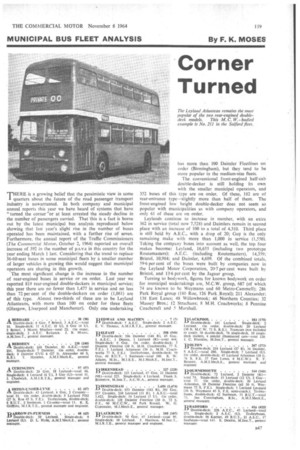Corner Turned
Page 121

If you've noticed an error in this article please click here to report it so we can fix it.
THERE is a growing belief that the pessimistic view, in some 1 quarters about the future of the road passenger transport industry is unwarranted. In both company and municipal annual reports this year we have heard of systems that have turned the corner "or at least arrested the steady decline in the number of passengers carried. That this is a fact is borne out by the latest municipal bus analysis reproduced below showing that last year's slight rise in the number of buses operated has been maintained, with a further rise of seven. Furthermore, the annual report of the Traffic Commissioners (The Commercial Motor, October 2, 1964) reported an overall increase of 392 in the number of p.s.v.s in this country for the year ending March I last. Considering that the trend to replace• 56-60-seat buses in some municipal fleets by a smaller number of larger vehicles is growing this would suggest that municipal operators are sharing in this growth.
The most significant change is the increase in the number of rear-engined buses in service or on order. Last year we reported 819 rear-engined double-deckers in municipal service; this year there are no fewer than 1,477 in service and no less than 72 per cent of the double-deckers on order (1,061) are of this type. Almost two-thirds of these are to be Leyland Atlanteans, with more than 100 on order for three fleets (Glasgow, Liverpool and Manchester). Only one undertaking has more than 100 Daimler Fleetlines on order (Birmingham), but they tend to be more popular in the medium-size fleets.
The conventional front-engined half-cab donhle-decker is still holding its own with the smaller municipal operators, and 352 buses of this type are on order. Of these, 182 are of rear-entrance type—slightly more than half of them. The front-engined low height double-decker does not seem so popular with municipalities as with company operators, and only 61 of these are on order.
Leylands continue to increase in number, with an extra 362 in service (total now 7,528) and Daimlers remain in second place with an increase of 100 to a total of 4,310. Third place is still held by A.E.C., with a drop of 20; Guy is the only remaining make with more than 1,000 in service (1,550). Taking the company buses into account as well, the top four makes become: Leyland, 16,655 (including two prototype Routemasters); A.E.C. (including Routernasters), 14,359; Bristol, 10,984; and Daimler, 4,699. Of the combined totals, 59.6 per cent of the buses were built by companies now in the Leyland Motor Corporation, 20-7 per cent were built by Bristol, and 13.6 per cent by the Jaguar group.
Turning to bodywork, figures for known bodywork on order for municipal undertakings are, M.C.W.group, 687 (of which 74 are known to he Weyrnann and 60 Metro-Cammell); 286 Park Royal group (160 Roe, 126 Park .Royal); 211 Alexander; 138 East Lanes; 48 Willowbrook; 46 Northern Counties; 32 Massey Bros.; 12 Strachans; 8 M.1-1. Coachworks; 8 Pennine Coachcraft and 5 Marshall.












































































































































































